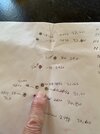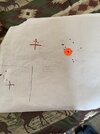Don't remember where I first heard of this, but the logic of it seems to hold up. For rifles, It seems there are two tuning dials you can turn. One is powder charge. The other is seating depth. So along the lines of chicken / egg and which came first debate, I've settled on powder charge comes first, Then seating depth if you need to go that far, with caveat that bullet seating depth to start is either something like 30 thousands off the lands, or to the COAL listed in the load.......or to SAMMI max if it will chamber. Either way, it is out far enough if you want to adjust it, you adjust it in 3 thousands intervals (seated deeper).
But as for powder charge, the increment that seems to hold up well is 1% of max charge in load data. So if max load is 50 grains, 1% is .5 grains. I have found i like to end at an accurate node close to full case capacity / max load, so I start at Max, then back down 6 increments from that. In above example, that would leave me at intervals of 47.5, 48.0, 48.5, 49, 49.5 and 50. That usually leaves me about halfway between min and max. Top half. Four rounds each. Lacking signs of pressure, best group that gets me close to factory ammo velocity wins. Then if you want to try to tune it more, same thing with seating depth. 4 rounds each, seated 3 thousands deeper, looking for an accuracy node inside what ought to be an already accurate load. Since I'm loading hunting ammo for hunting rifles, 1 MOA or better is good enough for my use and I can usually do that with no need to tinker with seating depth.
Pistols.......in my case 9mm.......COL to book or longer (seated further out), then increments of .2 grains. I'm looking at a combination of velocity and an easy shooting feel that loads and cycles the gun when fired. If I keep shooting enough of these, hope to someday get to the point where accuracy matters too.




